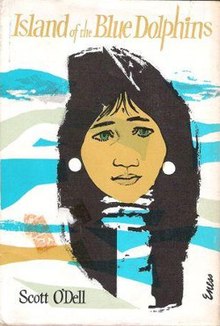Island of the Blue Dolphins

First edition
|
|
| Author | Scott O'Dell |
|---|---|
| Cover artist | Evaline Ness |
| Country | United States |
| Language | English |
| Genre | Children's novel |
| Publisher | Houghton Mifflin |
|
Publication date
|
1960 |
| Media type | Print (hardcover & paperback); Audiobook |
| Pages | 194 pp |
| ISBN | |
| OCLC | 225474 |
| Followed by | Zia |
Island of the Blue Dolphins is a 1960 children's novel written by Scott O'Dell and tells the story of a young girl stranded alone for years on an island off the California coast. It is based on the true story of Juana Maria, a Nicoleño Native American left alone for 18 years on San Nicolas Island during the 19th century.
Island of the Blue Dolphins won the Newbery Medal in 1961. It was adapted into a film of the same name in 1964. O'Dell later wrote a sequel, Zia, published in 1976.
The 50th Anniversary edition of Island of the Blue Dolphins includes a new introduction by Newbery Medalist Lois Lowry and also includes extracts from Father Gonzales Rubio in the Santa Barbara Mission's Book of Burials. Island of the Blue Dolphins: The Complete Reader's Edition, a critical edition edited by Sara L. Schwebel, was published in October 2016 by the University of California Press. It includes two chapters deleted from the book before publication.
This novel is based on the true story of Juana Maria, better known to history as "The Lone Woman of San Nicolas Island," a Nicoleño Native Californian left alone for 18 years on San Nicolas Island, one of the Channel Islands off the California coast, before being "discovered" and taken to the mainland in 1853 by sea otter hunter George Nidever and his crew. According to Nidever, the Lone Woman lived in a structure supported by whale ribs and stashed useful objects around the island. In 2009, University of Oregon archaeologist Jon Erlandson found two old redwood boxes eroding from an island sea cliff, with a whale bone placed on top of them. With colleagues René Vellanoweth, Lisa Barnett-Thomas, and Troy Davis, Erlandson salvaged the boxes and other artifacts before they were destroyed by erosion. Vellanoweth and Barnett-Thomas later excavated the interior of the boxes in a San Nicolas Island laboratory and documented nearly 200 artifacts of Nicoleño, Euro-American, and Native Alaskan manufacture. The boxes appear to have been cached intentionally some time between 1815 and 1853, quite possibly by Juana Maria herself. It was also believed the Lone Woman lived in a cave on the island. In 2012, Naval archaeologist Steve Schwartz believed he discovered the buried location of that cave and began an investigation, working with archaeologist René Vellanoweth and his students from California State University, Los Angeles. Commanders at the Navy base on the island about 65 miles southwest of Point Mugu ordered Schwartz to halt the dig in 2015.
...
Wikipedia
